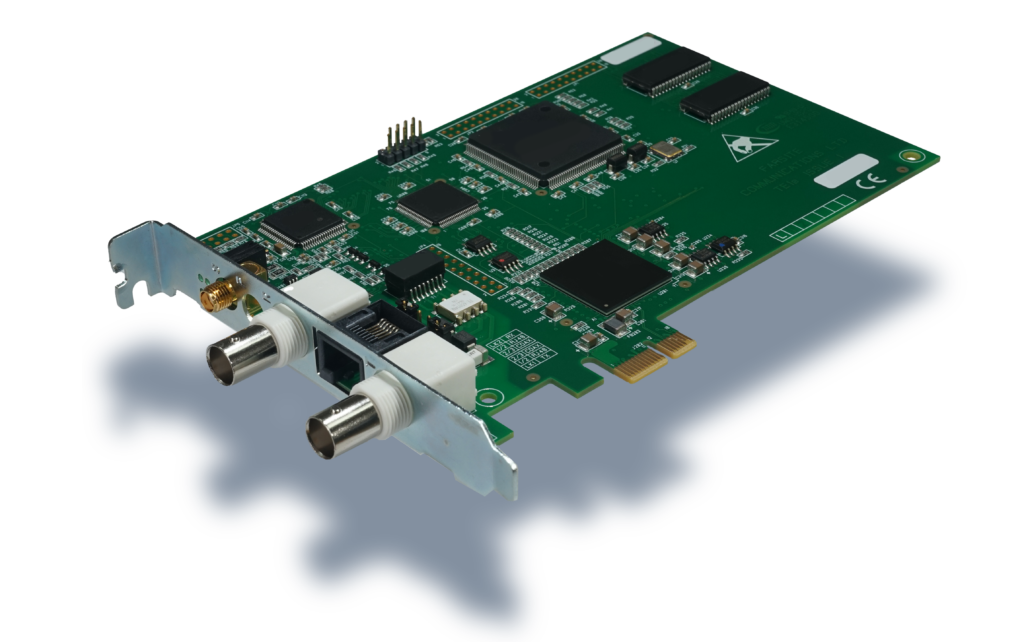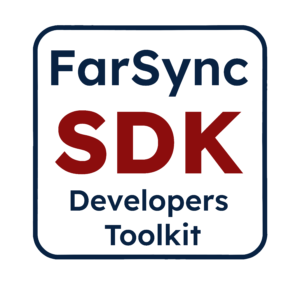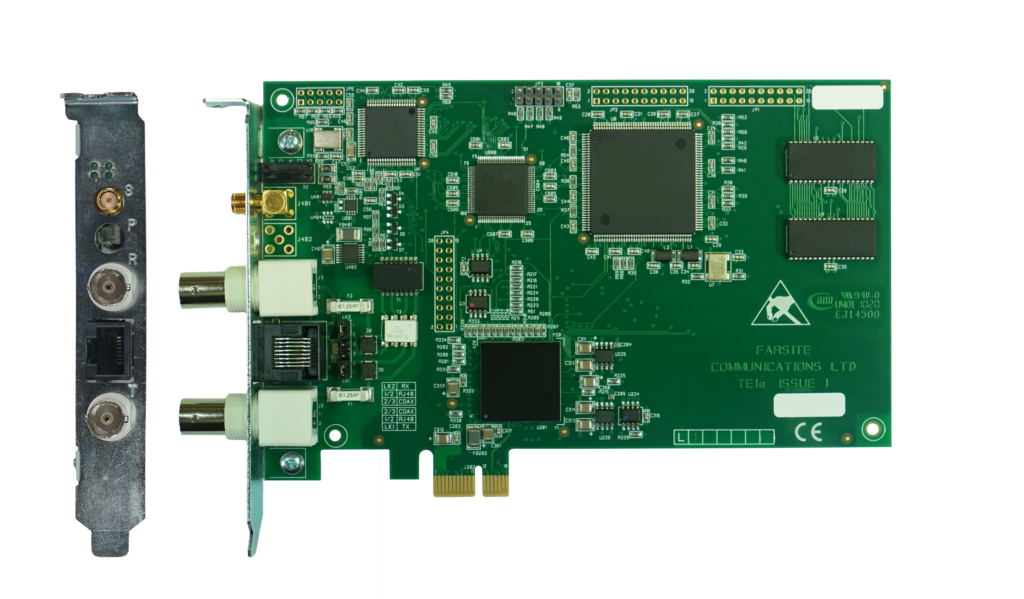FarSync TE1e – E1 card
The FarSync TE1e intelligent PCIe card provides an API to allow access to E1 G.703 and fractional E1 G.704 connectivity for Linux and Windows systems. A PCI version is also available.

Overview
The intelligent FarSync TE1e card brings comprehensive E1 support to Linux and Windows to allow your application full access to the E1 features available on the card. Full bandwidth on unstructured E1 G.703 lines, E1 fractional (G.703/G.704), HDLC framed and transparent operation are all supported with easy software configuration. The product includes a low level driver that allows access to the communications features available in the hardware.
Writing your own application to access our FarSync device? You will need to order the FarSync SDK alongside your hardware. One license is required per department or project.
The G.703 transparent bitstream option available with the API is suitable for video and voice such as T-DMB (Digital Multimedia Broadcasting), DAB (Digital Audio Broadcasting) ETI (Ensemble Transport Interface – ETSI EN 300 799) and STI (Service Transport Interface – ETSI EN 300 797) using the BNC connectors.
A general purpose bitstream encoding and decoding library including DAB-ETI (NI, G.703) and DAB-STI (PI, G.703), support to reduce application development timescales is available with the FarSync SDK.
Both the RJ48C (RJ45) and twin coax (BNC) connectors are available on the card so if you are not sure what connector type is going to be required, use the FarSync TE1e.
An external clock input of up to 10mhz through a SMA connector is supported to allow synchronisation of the output data clock, to, for example, a GPS source.
A PCI version of the card is also available, see the card hardware section.
The product is supplied with a 5 year warranty.
The FarSync adapters install easily under Windows 10, 8.1 Windows Server 2012, 2008, on single or multi-core 32 and 64 bit systems (excluding IoT editions). The FarSync drivers are signed by Microsoft for easy installation. For use on earlier Windows versions contact FarSite.
All FarSync cards/devices are supported by a set of Windows FarSync drivers that support FsWinAPI, an API that provides a consistent interface across all classes of FarSync cards/adapters. LabVIEW applications can also run over FsWinAPI thereby enabling VIs to utilise the FarSync ports.
FsWinAPI allows applications developed using the FarSync SDK to exactly control the type of data sent and received in bit synchronous (HDLC framed) data and transparent bitstream formats.
The FsWinAPI is an extension of the MS COMM API and enables, for example, applications developed to support COM ports, to be easily ported to use FarSync support in synchronous or asynchronous modes. This standardization enables the API to also be readily accessible from higher level environments such as .NET, C#, VB etc. The API provides applications with access to the card/device’s communications port/s for bit sync HDLC-framing or transparent bitstream operation (video and voice type applications). In addition asynchronous lines are supported by FarSync adapters that support async operation (FarSync Flex/Flex+ and FarSync T4Ee).
The product is supplied with a comprehensive configuration utility and its own Line Monitor that allows the user to record, display and store line traffic with WAN protocol decoding for fast debugging.
FarSync adapters support Linux kernel versions from 2.6.12 onwards, in 32 and 64 bit formats, including the leading distributions supplied by Red Hat, SuSE, CentOS, Ubuntu, Debian, Fedora, Slackware and more.
FarSite is committed to supporting FarSync adapters on new versions of Linux and Linux kernels as they are released.
Installation is simple, the driver is dynamically loadable so a kernel rebuild is not required for the driver to be installed. The driver acts as a dynamically loadable module. The driver is supplied with source code. The driver supports both big-endian and little-endian memory storage formats.
This adapter can be accessed from customers’ native Linux applications as well as those using third-party frameworks such as LabVIEW.
The char-based FarSync API provides a programming language independent, high-level interface to the FarSync base driver. This provides access to bit synchronous lines that are using HDLC-framed or transparent bitstreams. In addition asynchronous lines are supported by FarSync adapters that support async operation (FarSync Flex/Flex+ and FarSync T4E).
A configuration utility is provided to set each port’s line speed, interface type etc. Alternatively the port configuration can optionally be managed by a user application developed using the FarSync API.
If the host TCP/IP stack is required to be used over the FarSync adapter to allow access to IP-based networks, such as the Internet, then please just contact us for more information.
 The FarSync SDK provides a Developers Toolkit with full documentation, useful utilities, such as a line monitor, and many sample applications for Linux and Windows. Free support from FarSite’s Engineering department is provided to customers purchasing the FarSync SDK who have technical questions using the API.
The FarSync SDK provides a Developers Toolkit with full documentation, useful utilities, such as a line monitor, and many sample applications for Linux and Windows. Free support from FarSite’s Engineering department is provided to customers purchasing the FarSync SDK who have technical questions using the API.
Writing your own application? You will need to order the FarSync SDK alongside your hardware. One license is required per department or project.
The SDK includes support for writing applications on both Linux and Windows and contains documentation, working sample applications, development and test utility applications. There is everything a user needs to rapidly develop and test a wide variety of applications such as specialist synchronous (HDLC framed) protocols or transparent bitstream data requirements including Audio, MPEG Video T-DMB and DAB ETI with bitstream encoder and decoder.
The FarSync SDK is ordered separately from the FarSync adapter.
Our Engineering department provides free email and telephone assistance to application developers using the API as part of the package provided when the FarSync SDK is purchased.
See details on the FarSync SDK Developers Toolkit and the APIs supported.
Free 3rd party applications: The Open Digital Radio DAB/DAB+/T-DMB multiplexer, very good site for DAB developments.
See details on the FarSync TE1e card use in DAB
About and source code for the Open Digital RadioDAB/DAB+/T-DMB multiplexer. See also Open Digital Radio.
The FarSync cards are suitable for a very wide range of uses; some typical applications include:
- High speed multi-port HDLC framing support for non standard or specialist protocols
- Interfacing DAB ETI (Ensemble Transport Interface – ETSI EN 300 799) transparent bit streams to Servers
- Interfacing MPEG Video bit streams T-DMB ETI to Servers
- Interfacing high speed MPEG Video bit streams to Servers
- Watchdog systems
- Data generators for test systems
- Engineering monitoring and control systems
- Line connection card for LabVIEW applications
- Use of bitstreaming for the implementation of non standard or specialist protocols
- Multi purpose multi port communication card supplying a wide range of card generated clock speeds, FarSync T4Ee especially recommended for this function
- Manchester Encoding or Conditioned Diphase for long, reliable, high speed self clocking lines, FarSync Flex, FarSync K2Ee or FarSync T4Ee recommended for this requirement

Product details
Both PCIe and PCI E1 cards comprise an AMD processor with SRAM. The whole memory space may be mapped via the PCIe interface to the PC/Server. The card has an embedded HDLC / transparent controller with SDMA access (128 buffers per port) and a full range of timers.
Network Interfaces
The cards support E1 unstructured (G.703) and Transparent operation at 2.048 Mbits/s, E1 fractional (G.703/G.704) at speeds from 64 Kbits/s to 1.984 Mbits/s.
E1 Modes: HDLC-framed or transparent data over G.703 unframed/unstructured or G.703/G.704 framed/structured Doubleframe and CRC4 multiframe modes.
External Synchronisation Clock
Frequency: 10MHz, 5MHz, 2.048MHz, 1.544MHz or 1MHz.
Frequency Tolerance: Within 30ppm or better of supported speeds
Input Impedance: 75 ohms
Input Level:
Absolute Max: -7.5V to +12.5V
Typical: +/- 300 mV with a hysteresis of 50mV or G.703-13
Typical: HCMOS, square or sine wave
The external synchronisation clock feature is not available on the FarSync Te1 (PCI card).
Multiple Cards
The drivers supplied with Windows and Linux allow large numbers of ports to be supported by the installation of multiple FarSync cards in a Server. Typically 12 or more cards (24+ ports) can be supported; the card limit is only dependent on the resources available in the host Server and the total bandwidth of the PCIe/PCI/PMC bus.
PCI Express Bus Specification
FarSync PCIe cards are suitable for systems with a PCIe bus, covering single and multi-processor systems. These cards are compliant with PCI Express Base specification revision 1.0a and above. The FarSync adapters are bus mastering, 1x (single lane) cards.
FarSync PCI cards comply with the Universal PCI (PCI-X compatible, PCI v2.2 compliant) specification. These bus mastering cards are suitable for systems with a PCI bus, covering single and multi-processor systems.
The FarSync TE1
Click for the FarSync TE1 datasheet

| Linux | |
|---|---|
| Distribution and Kernel Support | FarSync adapters support Linux kernel versions from 2.6.12 onwards, in 32 and 64 bit formats, including the leading distributions supplied by Red Hat, SuSE, CentOS, Ubuntu, Debian, Fedora, Slackware and more. The products may operate successfully with earlier or later versions of the kernel but no specific testing has been undertaken by FarSite. Big Endian and Little Endian memory storage format drivers supplied. |
| Protocol Supported | Cisco HDLC, LAPB, Frame Relay, CHAP, MSCHAP, PAP (RFCs 1661, 1332, 1334). Bitstream. ETI (NI, V.11) with the FarSync SDK. |
| API and Interfaces | Char I/O API |
| Windows | |
| O/S Types | The FarSync adapters install easily under Windows 10, 8.1 Windows Server 2012, 2008, on single or multi-core 32 and 64 bit systems (excluding IoT editions). The FarSync drivers are signed by Microsoft for easy installation. For use on earlier Windows versions contact FarSite. |
| Protocol Supported | LAPB, V.120, CHAP, PAP (RFCs 1661, 1332, 1334), ETI (NI, V.11), Bitstream. |
| API and Interfaces | FsWinAPI, NDIS (LAN) where the line appears as a LAN interface |
| Utilities | Line Monitor to record, display and store line traffic included |
| Card type / PCIe spec | AMD processor with SRAM and FALC56 E1 comms controller, FarSync PCIe cards are suitable for systems with a PCIe bus, covering single and multi-processor systems. These cards are compliant with PCI Express Base specification revision 1.0a and above. The FarSync adapters are bus mastering, 1x (single lane) cards. |
||
| Physical characteristics | Short card (height 107mm, length 167mm) | ||
| Multiple cards | The drivers supplied with Windows and Linux allow large numbers of ports to be supported by the installation of multiple FarSync cards in a Server. Typically 12 or more cards (24+ ports) can be supported; the card limit is only dependent on the resources available in the host Server and the total bandwidth of the PCIe/PCI/PMC bus. |
||
| Network connectors | E1: 120-ohm RJ48C (often referred to as RJ45) or Twin 75 ohm BNC | ||
| Network connections supported | E1 unstructured (G.703) : 2.048 Mbits/s E1 fractional (G.704): 64 Kbits/s to 1.984 Mbits/s |
||
| E1 frame structure and modes | E1 - HDLC-framed or transparent data over G.703 unframed/unstructured or G.703/G.704 framed/structured Doubleframe and CRC4 multiframe modes |
||
| G.706 features | CRC4 to non-CRC4 interworking according to ITU-T G.706 Annex B (E1) Error checking via CRC4 procedures according to ITU-T G.706 (E1) |
||
| External Clock Input Specification | SMA Connector Frequency: 10MHz, 5MHz, 2.048MHz, 1.544MHz or 1MHz. Frequency Tolerance: Within 30ppm or better of supported speeds Input Impedance: 75 ohms Input Level: Absolute Max: -7.5V to +12.5V Typical: +/- 300 mV with a hysteresis of 50mV or G.703-13 Typical: HCMOS, square or sine wave |
||
| ESD protection | Sidactor and telelink fuse, designed for zero maintenance. The FarSync TE1e uses solid state fuses unlike many E1 interface cards, no parts need to be replaced after a survivable lightening strike. |
||
| Cables | 2 metre RJ-48C cable included, male connectors at both ends | ||
| Back panel indicators | LEDs for Port open, Loss of Signal (LOS), Receive Remote Alarm (RRA), Alarm Indication Signal (AIS) |
||
| Approvals | EN55022 class B, CE, FCC class B, TBR12 and TBR13 | ||
| Power requirements | < 1.4 Amp @ +3.3v < 5 watts | ||
| Operating Temperature Range | 0–60°C ambient air temperature. Note: a higher temperature range version -20 to +60°C ambient air temperature is available as an option, contact us for details. |
||
| MTBF | 270,000 Hours - Bellcore Method 1 Case 3, 40 deg.C ambient, 15 deg.C case temperature rise above ambient |
||
| Warranty | 5 years | ||
| Compliance | RoHS2, REACH | ||
Order Information
The software firmware, drivers, utilities are included with the FarSync adapter.
The software and documentation is downloaded from this website using a code supplied with the FarSync adapter, it includes:
- Drivers for Linux and Windows
- Source code for Linux drivers
- Network monitor and various useful utility programs
- Quick start guide
- RJ48C (RJ45) 2 metre male to male cable
New releases of the software with enhancements and fixes are made available for free download from the Download page in the Support section of this web site.
The Developer’s Toolkit is ordered separately and supplied as a download.
| Description | Product Code | |
| FarSync TE1e | Intelligent 1 port E1 adapter, PCI Express with BNC and RJ48C (RJ45) connectors, with an API for customer applications. | FS4155 |
| FarSync TE1 | Intelligent 1 port E1 adapter, PCI Express with BNC and RJ48C (RJ45) connectors, with an API for customer applications. | FS4150 |
